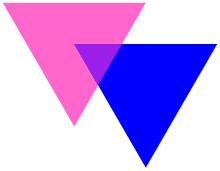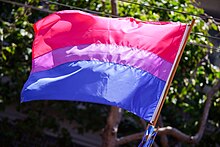Bisexual flag
 | |
| Use | Symbol of the bisexual community |
|---|---|
| Proportion | 3:5 |
| Adopted | 1998 |
| Design | Three solid horizontal bars: two fifths pink, one fifth purple, and two fifths blue. |
| Designed by | Michael Page |
| Part of the LGBTQ series |
| LGBTQ symbols |
|---|
| Symbols |
| Pride flags |

| Part of a series on |
| Bisexuality topics |
|---|
| Sexual identities |
| Studies |
| Attitudes, slang and discrimination |
| Community and literature |
| Lists |
| See also |
|
|

The bisexual flag, also called the bisexual pride flag, is a pride flag representing bisexuality, bisexual individuals and the bisexual community. According to Michael Page, the activist who created the flag based on a color palette designed by Liz Nania,[1][2] the pink stripe represents attraction to the same sex, while the blue stripe represents attraction to the opposite sex. The purple stripe, the resulting "overlap" of the blue and pink stripes, represents attraction to both sexes.[1]
Page designed the flag to increase the visibility of bisexuals among society as a whole and within the LGBT community. He aimed to give the bisexual community a symbol that is comparable to the rainbow flag for the greater LGBT community. The first bisexual pride flag was unveiled at the BiCafe's first anniversary party[3] on December 5, 1998.[4]
Design and colors
[edit]Page stated that he took the colors and overlap for the flag from the biangles, symbol of bisexuality.[1][2] The biangles symbol of bisexuality was designed by artist Liz Nania as she co-organized a bisexual contingent for the Second National March on Washington for Lesbian and Gay Rights in 1987.[5] The design of the biangles began with the pink triangle, a Nazi concentration camp badge that later became a symbol of gay liberation representing homosexuality. The addition of a blue triangle contrasts the pink and represents heterosexuality. The two triangles overlap and form lavender, which represents the "queerness of bisexuality", referencing the Lavender Menace and 1980s and 1990s associations of lavender with queerness.[2]
Page described the meaning of the pink, purple, and blue colors:[1][6]
The pink color represents sexual attraction to the same sex only (gay and lesbian). The blue represents sexual attraction to the opposite sex only (straight) and the resultant overlap color purple represents sexual attraction to both sexes (bi). The key to understanding the symbolism of the Bi Pride Flag is to know that the purple pixels of color blend unnoticeably into both the pink and blue, just as in the 'real world,' where bi people blend unnoticeably into both the gay/lesbian and straight communities.
Since the original design, the purple overlap has been reinterpreted and is now widely understood to represent attraction regardless of sex or gender.[7]
The flag is used in different aspect ratios; 2:3 and 3:5 are often used, in common with many other flags.[citation needed]
In vexillological terms, the bisexual pride flag is a simple horizontal tricolor.
The exact colors given by Page are PMS 226 for the pink, 258 for the purple, and 286 for the blue:[3][1]
- magenta (R 214, G 2, B 112)
- purple (R 155, G 79, B 150)
- royal blue (R 0, G 56, B 168)
The pink stripe takes up two fifths of the flag, the purple stripe takes up the middle fifth, and the blue stripe takes up the other two fifths.[1] The flag has been most commonly oriented with the pink stripe at the top, but both orientations are acceptable.[3] The flag is not patented, trademarked, or service marked.[1]
In 1999, Michael Page established the use of the trillium flower as a symbol of bisexuality,[8] and in 2001, Francisco Javier Lagunes Gaitán and Miguel Angel Corona designed a Mexican variant of the bisexual pride flag, which is emblazoned with an emblem of a trillium flower.[9][10][11]
Licensing controversy
[edit]In 1998, Page stated that the bisexual pride flag was "for free public and commercial use" and that it was "not patented, trademarked or service marked".[1] In April 2020, BiNet USA falsely claimed that it was the sole copyright owner of the flag and flag colors, and said organizations and individuals who wished to use the flag for commercial purposes would be required to obtain a license from the organization, despite having nothing to do with the flag's design or creation.[12] BiNet's claim and the resulting controversy were covered by Out and LGBTQ Nation, which cast doubt on BiNet's claim and noted that the flag is not eligible for copyright.[12][13]
BiNet USA ultimately ceased to use the flag on May 8, 2020, opting instead to use a different design.[14]
Other symbols representing bisexuality
[edit]Double Moon
[edit]
Because many bisexuals objected to the use of a symbol based on the pink triangle, Vivian Wagner designed the double moon as an alternative way to symbolize bisexuality.[15][16]
See also
[edit]- Bisexuality in the United States
- Bisexual community
- Bisexual lighting
- Celebrate Bisexuality Day
- LGBT symbols
References
[edit]- ^ a b c d e f g h "History, Bi Activism, Free Graphics". BiFlag.com. December 5, 1998. Archived from the original on August 1, 2001. Retrieved April 20, 2020.
- ^ a b c "Biangles, bisexual symbol, bi colors, bi history — Liz Nania". Liz Nania. Retrieved June 26, 2022.
- ^ a b c Young, Randy (June 6, 2015). "BiPride Flag". Flagspot. Flags of the World. Retrieved October 24, 2015.
- ^ "Counseling and Wellness Services - Safezone Symbols". October 20, 2013. Archived from the original on October 20, 2013. Retrieved December 28, 2021.
- ^ Jordahn, Sebastian (October 23, 2019). "Queer x Design highlights 50 years of LGBT+ graphic design". Dezeen. Retrieved June 12, 2021.
- ^ Rosiek, Jerry (2005). "Rainbow Flag and Other Pride Symbols". In Sears, James Thomas (ed.). Youth, Education, and Sexualities: An International Encyclopedia. Vol. 2. Westport, Conn.: Greenwood. p. 701. ISBN 0-313-32755-6.
- ^ "Flags of the LGBTIQ Community". Outright International. Retrieved June 22, 2023.
- ^ Eidson, Jessica. "Plants That Can Symbolize LGBTQIA+ Pride". Discover + Share. Missouri Botanical Garden.
- ^ Eyvanaki, Ashley. "Queer Objects: William Keble Martin Lily Illustration". out and about. University of Exeter. Retrieved August 14, 2024.
- ^ "Bisexual Botany". Lincoln Park Zoo. Lincoln Park Zoo. Retrieved August 14, 2024.
- ^ "Mexico - Sexual orientation flags". FOTW 'Flags Of The World' Website. Retrieved August 14, 2024.
- ^ a b Bollinger, Alex (April 29, 2020). "A group is threatening legal action & demanding payment for use of the bisexual pride flag". LGBTQ Nation. Retrieved April 29, 2020.
- ^ Street, Mikelle (April 29, 2020). "This Organization Wants to Be Paid for Use of the Bi Pride Flag". www.out.com. Out. Retrieved April 29, 2020.
- ^ Prager, Sarah (May 7, 2020). "A Bi Advocacy Group Claimed Copyright Over the Bi Pride Flag. Activists Were Outraged". them. Retrieved January 25, 2021.
- ^ Smith, Erika W. "Violets, Bi-Angles, And Double Moons: A Guide To LGBTQ+ Symbols". www.refinery29.com. Archived from the original on September 7, 2024. Retrieved April 19, 2024.
- ^ Koymasky, Matt; Koymasky Andrej (August 14, 2006). "Gay Symbols: Other Miscellaneous Symbols". Archived from the original on April 9, 2011. Retrieved February 18, 2007.
